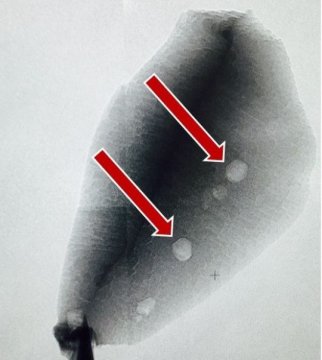.

Carbon in 4.1 billion year old zircon.
Credit: Stanford/UCLA.
-
UCLA geochemists have found evidence that life likely existed on Earth at least 4.1 billion years ago -- 300 million years earlier than previous research suggested. The discovery indicates that life may have begun shortly after the planet formed 4.54 billion years ago.
The research is published today in the online early edition of the journal Proceedings of the National Academy of Sciences.
"Twenty years ago, this would have been heretical; finding evidence of life 3.8 billion years ago was shocking," said Mark Harrison, co-author of the research and a professor of geochemistry at UCLA.
"Life on Earth may have started almost instantaneously," added Harrison, a member of the National Academy of Sciences. "With the right ingredients, life seems to form very quickly."
The new research suggests that life existed prior to the massive bombardment of the inner solar system that formed the moon's large craters 3.9 billion years ago.
"If all life on Earth died during this bombardment, which some scientists have argued, then life must have restarted quickly," said Patrick Boehnke, a co-author of the research and a graduate student in Harrison's laboratory.
Scientists had long believed the Earth was dry and desolate during that time period. Harrison's research -- including a 2008 study in Nature he co-authored with Craig Manning, a professor of geology and geochemistry at UCLA, and former UCLA graduate student Michelle Hopkins -- is proving otherwise.
"The early Earth certainly wasn't a hellish, dry, boiling planet; we see absolutely no evidence for that," Harrison said. "The planet was probably much more like it is today than previously thought."
The researchers, led by Elizabeth Bell -- a postdoctoral scholar in Harrison's laboratory -- studied more than 10,000 zircons originally formed from molten rocks, or magmas, from Western Australia. Zircons are heavy, durable minerals related to the synthetic cubic zirconium used for imitation diamonds. They capture and preserve their immediate environment, meaning they can serve as time capsules.
The scientists identified 656 zircons containing dark specks that could be revealing and closely analyzed 79 of them with Raman spectroscopy, a technique that shows the molecular and chemical structure of ancient microorganisms in three dimensions.
Bell and Boehnke, who have pioneered chemical and mineralogical tests to determine the condition of ancient zircons, were searching for carbon, the key component for life.
One of the 79 zircons contained graphite -- pure carbon -- in two locations.
"The first time that the graphite ever got exposed in the last 4.1 billion years is when Beth Ann and Patrick made the measurements this year," Harrison said.
How confident are they that their zircon represents 4.1 billion-year-old graphite?
"Very confident," Harrison said. "There is no better case of a primary inclusion in a mineral ever documented, and nobody has offered a plausible alternative explanation for graphite of non-biological origin into a zircon."
The graphite is older than the zircon containing it, the researchers said. They know the zircon is 4.1 billion years old, based on its ratio of uranium to lead; they don't know how much older the graphite is.
The research suggests life in the universe could be abundant, Harrison said. On Earth, simple life appears to have formed quickly, but it likely took many millions of years for very simple life to evolve the ability to photosynthesize.
The carbon contained in the zircon has a characteristic signature -- a specific ratio of carbon-12 to carbon-13 -- that indicates the presence of photosynthetic life.
"We need to think differently about the early Earth," Bell said.
Wendy Mao, an associate professor of geological sciences and photon science at Stanford University, is the other co-author of the research.
The research was funded by the National Science Foundation and a Simons Collaboration on the Origin of Life Postdoctoral Fellowship granted to Bell.
Quelle: UCLA
3826 Views
